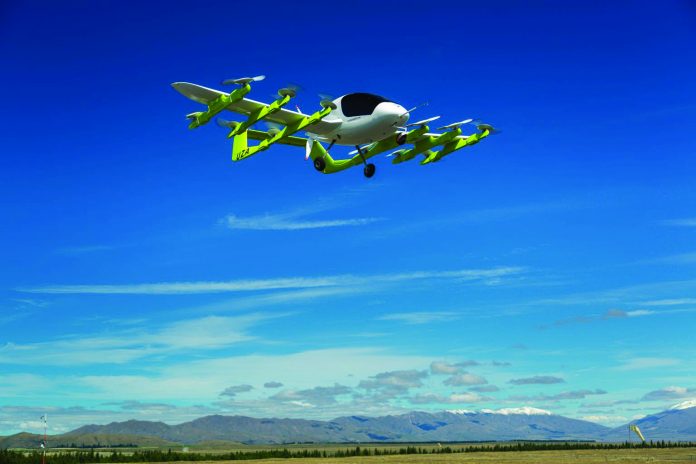The long-anticipated wait for flying cars may soon be over, and Hollister may find its place as a modern-day Kitty Hawk in the annals of modern aviation as the birthplace of the first personal aviation craft. On Monday Google co-founder Larry Page began to reveal details about Cora, a compact pilotless air taxi, that could completely alter the way modern people move from place to place.
Since the Hollister Free Lance first reported on Zee.Aero’s flying car project and rental of Building 19 at Hollister Airport in 2014, Google co-founder Larry Page’s stealth venture has been one of the worst kept secrets in town. Airport neighbors reported sightings of the electric powered aircraft and shared photographs. In June 2016, Bloomberg reported that Page had personally invested $100 million in Zee.Aero and Kitty Hawk.
Kitty Hawk has now merged with Zee.Aero, and its New Zealand operating unit has gotten the green light to begin commercial service there next year. And the once tight-lipped company is now talking publicly about its ambitions.
“After almost eight years of exploring new frontiers, we had built the aircraft we had been dreaming of, Cora,” Kitty Hawk said in a press release. “An electric, autonomous fully fledged air taxi that takes off like a helicopter and flies like a plane. The first step to a world where the freedom of flight belongs to everyone.”
Can San Benito County, with available land and proximity to Silicon Valley, become, not only a new Kitty Hawk— the North Carolina town made famous by the Wright Brothers famous 1903 flight—but perhaps a veritable Area 51 like design center for further space-age innovation?
Those mysteries are still tightly guarded by the company, and aside from their website, details are in short supply.
Cora, an all-electric air taxi, seats two people, can reach 110 MPH and an altitude between 500 and 3000 feet. The vehicle takes off like a helicopter, powered by 12 independent lift fans and has a range of 62 miles according to a document released by Kitty Hawk.
“After almost eight years of engineering, re-engineering, and re-re-engineering, we had done it,” read a statement from the company’s website. “We had designed an air taxi, affectionately named Cora, that could take off like a helicopter and transition to flying like a plane. The possibilities were limitless.”
Aside from Page, Google roots run deep in Kitty Hawk. CEO Sebastian Thrun founded the research-and-development “moonshot factory” Google X, which operates as a subsidiary of Google parent Alphabet Inc., as well as Google’s self-driving car team. The self-driving technology is a vital piece to ensure the project’s safety.
According to a media fact sheet released by the company, Kitty Hawk hopes to make flight accessible to everyone and a part of our “daily lives.” While the design is meant to be part of our daily lives, the company does not envision Cora being in our garages, but rather to be operated as a flying ride-sharing service.
“Cora will use self-flying software combined with human oversight to make flying possible for people without training,” a company statement read. “Cora is powered by the same kind of technology that helps electric cars.”
This story was updated at 4:30pm on March 14, 2018.











Actually this has been going on for over 100 years. Glenn Curtiss patented a flying car in 1917, perhaps 100 different designs have been analyzed and widely discussed. Only about a dozen concept vehicles flew and drove on roads. Because of the incredible design, engineering, legal, and licensing challenges of building a flying car, just two designs have ever been certified by the CAA (now FAA) as aircraft—and the Taylor Aerocar of 1959 is the only one that was ever produced. Six Aerocars were built, sold, and flown. Naturally these all required pilot/drivers to operate. Technology has advanced and improved a bit over the last 100 years!
can i make an offer
can i make an offer